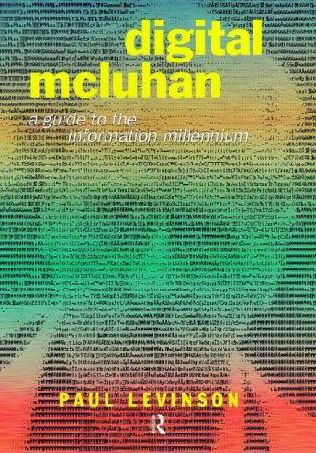Paul Levinson: Digital McLuhan: A Guide to the Information Millennium (1999)
Filed under book | Tags: · computing, global village, internet, mass media, media, media theory

“Marshall McLuhan died on the last day of 1980, on the doorstep of the personal computer revolution. Yet McLuhan’s ideas, developed in the 1950s, ’60s and ’70s, presaged a world of media in motion, and its impact on our lives on the dawn of the new millennium. McLuhan’s phrase, “the medium is the message” is his best known and most misunderstood concept. Paul Levinson presents the accuracy of McLuhan’s thinking unavailable while he was alive, and shows him as a man struggling to communicate in an electronic pattern via the straightjacket of paper. Levinson also examines why McLuhan’s theories about media are more important to us today than when they were first written, and why the Wired generation is now turning to McLuhan’s work to understand the global village in the digital age. By exploring the technological influence in industries from publishing to politics, entertainment to business, McLuhan opened the doors for understanding the human relationship with technology. Levinson’s own exploration of McLuhan’s significance in the new electronic generation clarifies the prophetic insights, principles and constructs in McLuhan’s work.”
Publisher Routledge, 1999
ISBN 041519251X, 9780415192514
226 pages
Keywords and phrases: personal computer, theremin, rear-view mirror, Marshall McLuhan, tetrad, Connected Education, Neil Postman, RealAudio, mass media, CP/M, Communications Decency Act, global village, Media Ecology, Internet, Gutenberg Galaxy, Paul Levinson, voyeurs, Eric McLuhan, Kaypro, RealVideo.
PDF (updated on 2022-11-12)
Comments (4)Rául Rojas, Ulf Hashagen (eds.): The First Computers: History and Architectures (2000)
Filed under book | Tags: · computing, history of computing, history of technology, technology

This history of computing focuses not on chronology (what came first and who deserves credit for it) but on the actual architectures of the first machines that made electronic computing a practical reality. The book covers computers built in the United States, Germany, England, and Japan. It makes clear that similar concepts were often pursued simultaneously and that the early researchers explored many architectures beyond the von Neumann architecture that eventually became canonical. The contributors include not only historians but also engineers and computer pioneers.
An introductory chapter describes the elements of computer architecture and explains why “being first” is even less interesting for computers than for other areas of technology. The essays contain a remarkable amount of new material, even on well-known machines, and several describe reconstructions of the historic machines. These investigations are of more than simply historical interest, for architectures designed to solve specific problems in the past may suggest new approaches to similar problems in today’s machines.
Publisher MIT Press, 2000
ISBN: 0262181975, 9780262181976
471 pages
Key words and phrases
ENIAC, EDSAC, Konrad Zuse, DEHOMAG, vacuum tubes, EDVAC, IAS computer, punched tape, parametron, mantissa, magnetic drum, punched card, analog computer, John von Neumann, Manchester Mark, Zuse KG, delay lines, floating-point, lambda calculus, Howard Aiken
PDF (updated on 2012-7-25)
Comment (1)David Alan Grier: When Computers Were Human (2005)
Filed under book | Tags: · computing, cybernetics, history of computing, history of technology, technology

“Before Palm Pilots and iPods, PCs and laptops, the term “computer” referred to the people who did scientific calculations by hand. These workers were neither calculating geniuses nor idiot savants but knowledgeable people who, in other circumstances, might have become scientists in their own right. When Computers Were Human represents the first in-depth account of this little-known, 200-year epoch in the history of science and technology.
Beginning with the story of his own grandmother, who was trained as a human computer, David Alan Grier provides a poignant introduction to the wider world of women and men who did the hard computational labor of science. His grandmother’s casual remark, “I wish I’d used my calculus,” hinted at a career deferred and an education forgotten, a secret life unappreciated; like many highly educated women of her generation, she studied to become a human computer because nothing else would offer her a place in the scientific world.
The book begins with the return of Halley’s comet in 1758 and the effort of three French astronomers to compute its orbit. It ends four cycles later, with a UNIVAC electronic computer projecting the 1986 orbit. In between, Grier tells us about the surveyors of the French Revolution, describes the calculating machines of Charles Babbage, and guides the reader through the Great Depression to marvel at the giant computing room of the Works Progress Administration.
When Computers Were Human is the sad but lyrical story of workers who gladly did the hard labor of research calculation in the hope that they might be part of the scientific community. In the end, they were rewarded by a new electronic machine that took the place and the name of those who were, once, the computers.”
Published by Princeton University Press, 2005
ISBN 0691091579, 9780691091570
411 pages
Key terms:
Mathematical Tables Project, Gertrude Blanch, Karl Pearson, Applied Mathematics Panel, Charles Henry Davis, Halley’s comet, Warren Weaver, Oswald Veblen, Wallace Eckert, Ida Rhodes, Benjamin Peirce, Charles Babbage, ENIAC, Aberdeen Proving Ground, Harvard Observatory, Lyman Briggs, John von Neumann, Bell Telephone Laboratories, human computers, Edmund Halley
DJVU (updated on 2012-7-25)
Comment (1)
